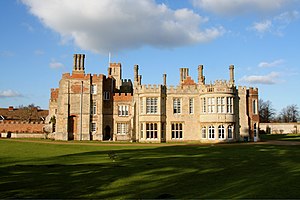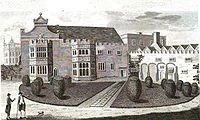Hinchingbrooke House


Hinchingbrooke House stands by Huntingdon in Huntingdonshire. It was built around an 11th-century nunnery but after the Reformation the lands of the convent passed into the hands of the Cromwell family, and subsequently, became the home of the Earls of Sandwich (including John Montagu, 4th Earl of Sandwich, reputedly the inventor of the modern sandwich).
History
The nunnery of Hinchinbrook was dissolved in 1538 during the Dissolution of the Monasteries under King Henry VIII; a process supervised nationally by Thomas Cromwell. On 8 March 1538, Thomas Cromwell's maternal nephew, Richard Williams (alias Cromwell), had the grant of the nunnery of Hinchinbrook, in Huntingdonshire, for the price of £19. 9s. 2d. while he was an official Visitor overseeing the dissolutions.[1] Richard's son, Henry Williams (alias Cromwell), a grandfather of Oliver Cromwell, built the house adjoining to the nunnery,[2] and upon the bow windows he put the arms of his family, with those of several others to whom he was allied.[3]
In 1970, the house became part of Hinchingbrooke School,[4] housing the 6th form.
Hinchingbrooke School
Hinchingbrooke School was formerly Huntingdon Grammar School which, on the site of what is now the Cromwell Museum in Huntingdon, was attended by Oliver Cromwell and later by Samuel Pepys.[5][6] The school now has around 1900 pupils.[7]
More recently, while still being used as a school, Hinchingbrooke House has also become used as a conference centre, and is also for, dinner dances and as a wedding venue. It is a Grade I listed building and is open for tours on Sunday afternoons in the summer season.[8][9] [10]
Outside links
| ("Wikimedia Commons" has material about House Hinchingbrooke House) |
- Map: 52°19’43"N, 0°12’5"W
References
- ↑ Noble 1784, p. 7 cites: Grant in the possession of the Earl of Sandwich.
- ↑ "The nuns apartments, or cells, at Hinchinbrook, are now entire, and are used as lodging-rooms for the menial servants; their common room was what is now the kitchen; the church is destroyed, except some trifling remains, now part of one of the walls of the house, and seem to have been the corner of the tower; near this place in lowering the flooring, a few years ago, one or more coffins of stone were found." (Noble 1784, p. 21 writing in 1787)
- ↑ Noble 1784, p. 22, Cites: Vide the engravings of the arms at Hinchinbrook.
- ↑ HH staff
- ↑ Goldsmith 1999.
- ↑ Grey 2004, The History of Hinchingbrooke House.
- ↑ Grey 2004, The Headmasters & The School
- ↑ HH staff
- ↑ Grey 2004, Hinchingbrooke House.
- ↑ National Heritage List 1128649: Hinchingbrooke House
- John, Goldsmith, ed (1999). "exhibitions>Cromwell>Where did he come from?". Cambridgeshire Education, Libraries and Heritage. http://www.lib.cam.ac.uk/exhibitions/Cromwell/where.htm.
- Grey, Duncan, ed (2004). "Hinchingbrooke House". The History of Hinchingbrooke House (website). http://www.hinchhouse.org.uk/. Retrieved November 2011.
- HH staff. "About Hinchingbrooke House". Hinchingbrooke House and Performing Arts Centre. http://www.hhpac.co.uk/aboutus.htm.
- Noble, Mark (1784). Memoirs of the Protectorate-house of Cromwell: Deduced from an Early Period, and Continued Down to the Present Time,.... 2. Printed Pearson and Rollason.
- "Memoirs of the Protectorate-house of Cromwell: Deduced from an Early Period, and Continued Down to the Present Time,...", by Mark Noble (1784)
